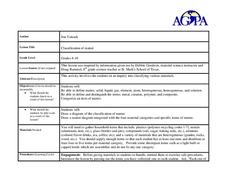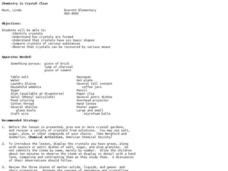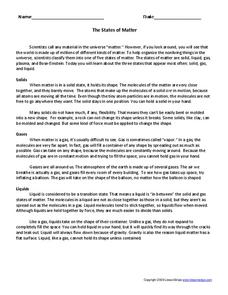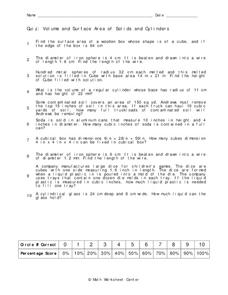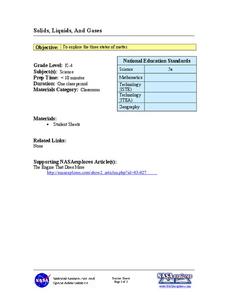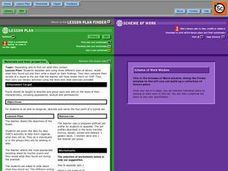Curated OER
Classification of Matter
Students investigate common household items and classify them into types of matter. For this matter lesson, students group given items into categories based on their characteristics. They also complete a concept map about matter and...
Curated OER
It's The States of Matter
Students investigate the properties of solids, liquids and gases. In this states of matter lesson plan, students observe dry ice and its characteristics. They calculate the density of dry ice and observe the sublimation of the dry ice...
Curated OER
Change of State
Students investigate the change of states of Butyl Stearate and the temperatures at which it changes state. In this change of state lesson plan, students place a test tube of Butyl Stearate in a cold water bath and monitor its...
Curated OER
Chemistry is Crystal Clear
Students observe crystals and their shapes and formation. In this crystal formation lesson plan, the teacher prepares crystal gardens for the students to observe, then the class finds examples of crystals in nature and observe a teacher...
Curated OER
States of Matter
In this states of matter worksheet, students answer 4 questions about solids, liquids, gases and plasma. They compare the particles of each and draw diagrams showing the particles in each state of matter.
Curated OER
Heat Transfer & Phase Changes
In this heat transfer and phase change worksheet, students experiment with ice, salt, and milk to show the relationship between the temperature of a solution and its phase. Students turn milk from a liquid to a solid and graph the...
Curated OER
Solid, Liquid or Gas?
Students explore solid, liquids, and gases. In this science lesson plan, students distinguish similarities and differences of matter and recognize that different states of matter may appear in one substance.
Curated OER
States of Matter: Solids, Liquids and Gases
Young scholars explore various states of matter. In this science lesson plan, students recognize the properties of each state of matter and recognize the similarities and differences between the three states of matter.
Curated OER
Matter and Energy
In this matter and energy worksheet, students identify substances as solids, liquids or gases, they use the kinetic theory to describe the motion of particles and they explain the conservation of mass and energy when a substance changes...
Curated OER
Dissolving Solids and Gases
In this dissolving solids and gases instructional activity, students learn that the process of dissolving gas is opposite of the process of dissolving solids. Students answer 3 critical thinking questions about dissolving gases and...
Curated OER
Comparing Solids, Liquids, and Gases
In this solids, liquids and gases learning exercise, students observe a teacher demonstration about gases and they experiment with liquids to show diffusion, shape and volume. They answer nine questions about the experiments related to...
Curated OER
Thermochemistry
For this thermochemistry worksheet, students indicate whether the given processes are endothermic or exothermic reactions. Students complete the phase change diagram as well as define a given set of vocabulary words. Students calculate...
Curated OER
The States of Matter
For this states of matter worksheet, students learn about the 3 different states of matter and how matter shifts states. They then answer the 20 questions in the packet. The answers are on the last page.
Curated OER
Volume and Surface Area
In this volume and surface area instructional activity, 10th graders solve and complete 10 different word problems that include measuring various solids and cylinders. First, they determine the surface area of a cube and the edge of it....
Curated OER
States of Matter
In this states of matter worksheet, students will brainstorm and write down facts about solids, liquids, and gases in a graphic organizer.
Curated OER
Geometry
In this rectangles and shapes worksheet, students complete a variety of exercises including counting the number of faces on a solid object, coloring solids to match nets and coloring plane shapes. Students check their answers online as...
Curated OER
Solids, Liquids, and Gases
Students investigate and explore the three states of matter. They read and discuss the NASA article "The Engine That Does More," identify examples of each state of matter, and as a class complete a section of two worksheets. They...
Curated OER
Discovering the Properties of Matter
Students identify the properties of the three states of matter and observe the movement of Oobleck and be able to compare its movement to that of solids and liquids. They record in their Science Journal what they discovered about Oobleck.
Curated OER
Waterproof Paper
Students explore matter through the concept of displacement. They perforrm an inquiry experiment with a glass, paper and a bucket to demonstrate that gases take up space.
Curated OER
Properties of Matter
Students describe four states of matter and their characteristics, explain thermal expansion of matter, interpret state changes in terms of kinetic theory of matter, explain relationship between temperature and volume of a gas, state...
Curated OER
Solids, Liquids and Gases
Students are introduced to the various states of matter. After watching a video, they discover how to compare the three states using its shape and volume. In groups, they participate in an experiment with solids, liquids and gases and...
Curated OER
Three States of Matter
Third graders investigate the three states of matter and the properties of materials as they undergo physical changes. They identify examples of each type of matter, role-play atoms in solids, liquids, and gases, and conduct an...
Curated OER
The Physical Behavior of Matter
Young scholars distinguish between three phases of matter: solid, liquid and gas, on the molecular level. They compare and predict the relative compressibility of the three phases of matter through journal writings and drawings.
Curated OER
Materials And Their Properties
Seventh graders investigate the particulate level of solids, liquids, and gases. They examine how the particle method show the interplay between scientific theories and evidence.


